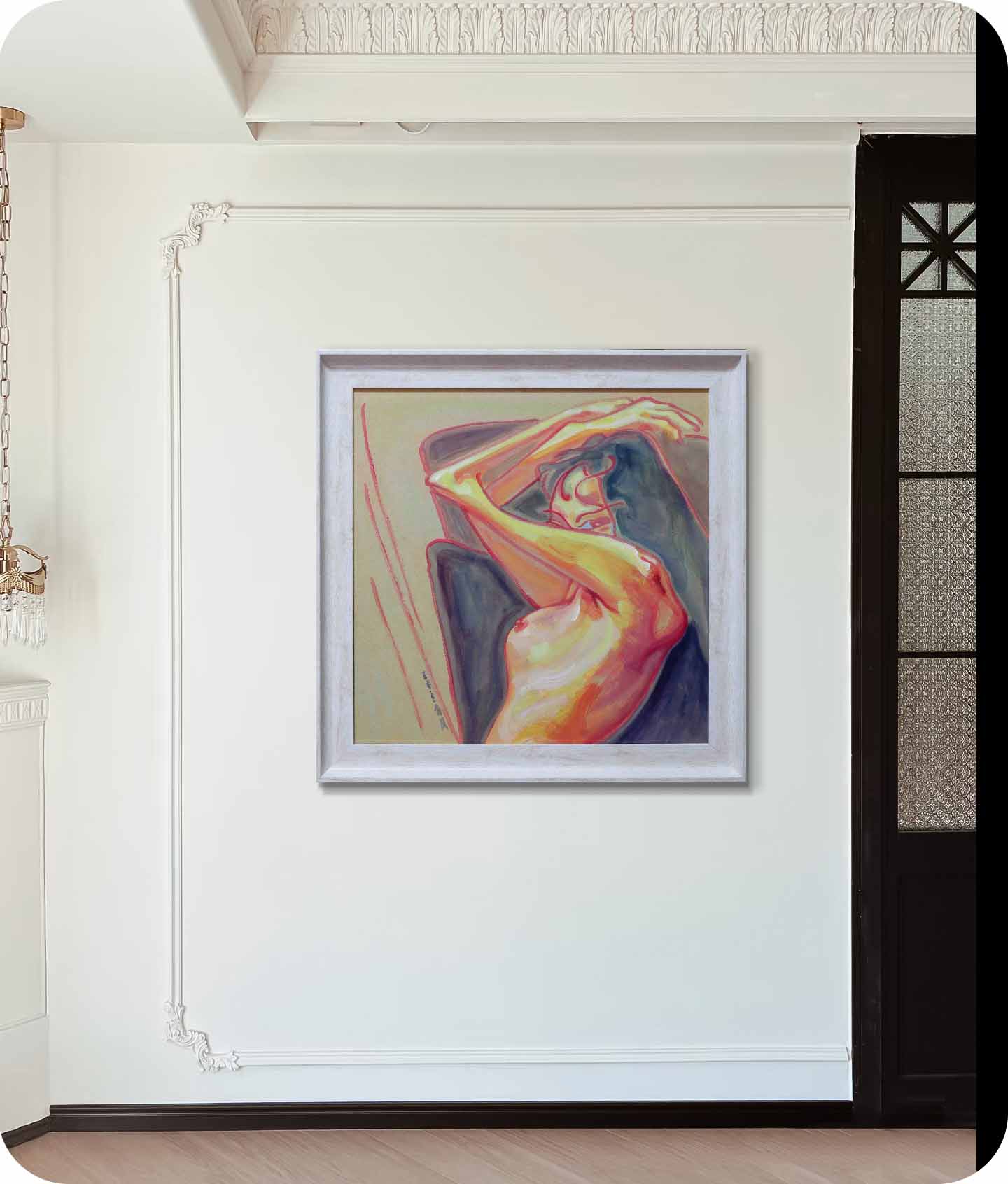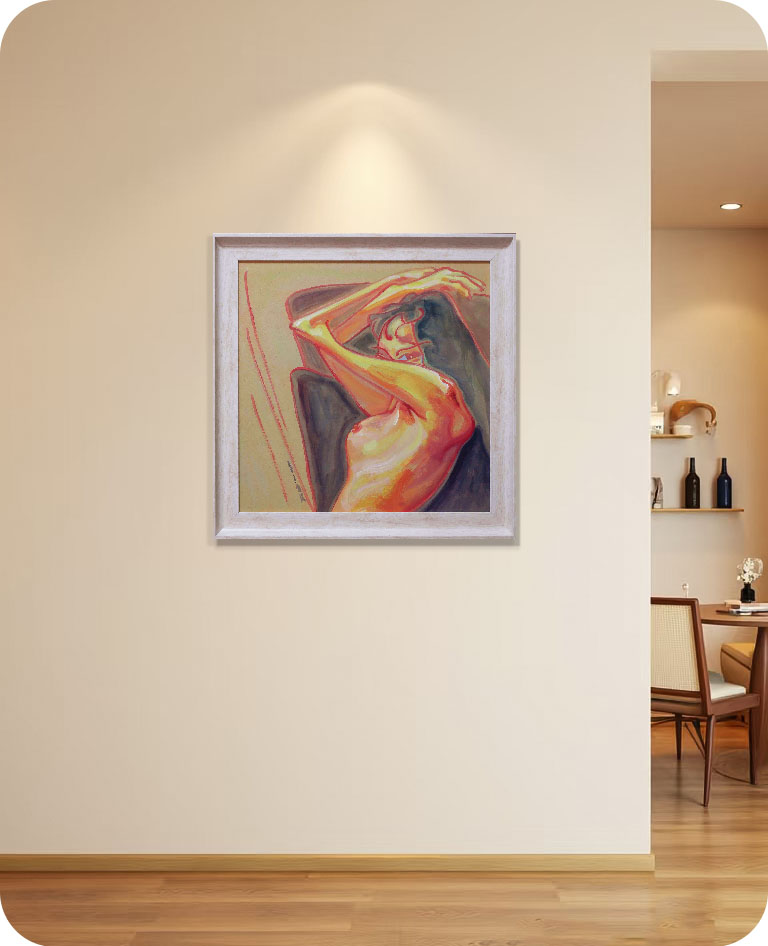The theme of this year's painting clearly states one - the makeup of desire. People's various desires are wrapped under various makeups. Desires are the intertwining of happiness and pain in life. Either straightforward or subtle, they will appear in makeup, forming a profound look of an era.
Inches: 15.7 x 15.7 in
Size without the frame: 40 x 40 cm
Country: China
Date: 2025
Materials: Acrylic paint on Wood
Condition: well preserved
Creative themes and style | My works revolve around the creative concept of "The land of humanity, People on the land".The people in the painting are people in nature, and the lines, shapes, and colors are close to nature. The nature in the painting is nature in the eyes of humans, existing in interaction with humans.I don’t pursue a series of works with a fixed and continuous style. I hope that the style of the pictures will synchronize with the changes in my life and always remain oscillating. The performance of the work must be in sync with the development of one's own life in order to be Sincere and powerful.Ideas are later.
An Interview with Artist Philo by Artphiloso Gallery
If you would like to collect this artwork or know more about the artist, please contact us.


Expressive Language and Break from Realism
This painting employs a highly expressive artistic language, breaking free from the constraints of realism to expose the soul’s soliloquy through the collision of color and line. Rather than presenting the body in naturalistic terms, it transforms the human form into an emotional landscape, where every distortion becomes a symbol of psychic intensity.
Form and Distortion
The human figure undergoes bold distortion, with twisted limbs and exaggerated proportions that nonetheless retain a sense of internal order. This expressive deformation channels erupting emotions into visible structure. Such treatment recalls Egon Schiele’s nudes, where sharp lines and contorted bodies probe the deepest recesses of human existence. Here, unconventional anatomy becomes a medium for conveying the spiritual tension of liberation and rupture.
Composition and Spatial Pressure
The composition is compact and nearly oppressive. The figure curls within the confines of the frame, its contours slicing space with blade-like precision. The contrast between the dark, weighty background and the vivid, heated flesh tones generates an atmosphere of tension. This strategy echoes the compositional logic of Francis Bacon, who similarly compressed and distorted space to intensify psychic anxiety. By doing so, the work traps the viewer’s gaze, forcing direct confrontation with its raw emotional charge.
Color and Emotional Intensity
Warm reds and luminous yellows surge across the body, creating an impression of scorching heat. Crimson lines at the edges heighten agitation, while the grey-blue background functions as a repressive counterforce. The subjective and highly emotional deployment of color recalls Edvard Munch’s The Scream—where color becomes an outlet for psychic storms. In this painting, burning hues embody the searing intensity of the “scorching sun” and the struggle of the human soul under its relentless blaze.
Brushwork and Gesture
The brushwork is unrestrained and vigorous. Sweeping strokes coexist with delicate accumulations of pigment, producing a surface that is at once coarse and tender. This recalls Willem de Kooning’s Abstract Expressionism, where the brushstroke operates as a direct conduit of emotion. Here, every mark reads as an annotation of feeling—each stroke a visceral howl of the spirit.
Theme and Content
At its core, the painting meditates on the existential condition of the human being. By employing the nude, it strips away social and external constraints, revealing an individual caught in solitude, struggle, and relentless self-scrutiny. The reference to the “end of the scorching sun” suggests both exhaustion and exposure, where the body becomes the battlefield of psychological conflict. This recalls Lucian Freud’s relentless excavation of flesh, though here the treatment is far more violent in form, using distortion to penetrate the abyss of the soul.
Emotional Expression
The emotional impact is volcanic—distorted form, surging color, and wild brushwork fuse into a raw, searing intensity. From the body’s contraction and expansion, and from the collision of colors, the viewer senses the trembling of the soul under duress. The work ultimately offers a scalding interrogation of life’s essence, translating inner torment into visible form.
Egon Schiele, Reclining Woman
Expresses psychic tension through distorted anatomy and sharp, nervous lines. Both works share a commitment to dissecting the soul via the raw immediacy of the human body.
Edvard Munch, Puberty
Uses intense color contrasts and contorted form to embody the anxieties of adolescence. Like this painting, it demonstrates the explosive emotional potential of color and line.
Francis Bacon, Study after Velázquez’s Portrait of Pope Innocent X
Compresses space and distorts form to magnify existential terror, resonating with this painting’s compact, oppressive composition.
Willem de Kooning, Woman I
Explores the human figure through sweeping, aggressive brushwork, where paint itself becomes an embodiment of emotion.
Lucian Freud, Reflection (Self-portrait)
Probes the human body as a vehicle for psychological truth, paralleling the raw self-exposure found in this painting.
The bold red contour lines not only emphasize the figures' curves and limb structure, but also add a sense of passionate, sensual tension. They create a striking warm color resonance with the yellows and oranges of the skin.
The arms are deliberately elongated and curve in a streamlined way. This breaks natural proportions, creating a rhythmic flow in the composition. It also guides the viewer's eye upward from the lower torso to the focal point of the gaze.
Although an arm blocks half the face, the intensely rendered eyes, framed by deep blue and red lines, pierce through the composition. This creates a powerful visual and psychological tension from the semi-concealed gaze.
The skin uses layered mixtures of yellow, orange, pink, and touches of white. Combined with the red contour lines and purplish-gray shadows, this technique captures light and shadow while making the body appear warm and dynamic.
The subdued backdrop of grayish-green and deep blue provides a cool, calm contrast that makes the figure's warm skin tones stand out dramatically. Its irregular shapes add an abstract quality to the composition, liberating it from strict realism.
A: Click here to view ARTPHILOSO's Guide for Collectors.
More paintings from this series:
End of the Blazing Sun 3 End of the Blazing Sun 4
End of the Blazing Sun 5 End of the Blazing Sun 6
End of the Blazing Sun 7 End of the Blazing Sun 8
End of the Blazing Sun 9 End of the Blazing Sun 10
